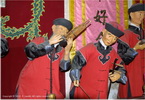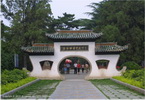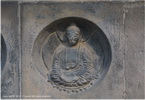|
LUOYANG
area |
|
|
 |
Luze Assembly Hall
潞泽会馆 |
|
GPS: |
34.67916,
112.48895 |
|
Luoyang Folk Museum is built at
the former site of Luze Assembly
Hall, which was built in 1744,
which was as one of the most
famous ancient architectural
complexes in the Qing Dynasty.
In 1981, it was called Yuxi
Museum and changed to its
current name as Luoyang Museum
in 1987. |
 |
|
| |
|
|
|
|
|
|
 |
Wenfeng
Park |
xxxxx |
GPS: |
na |
|
N/A |
|
|
|
|
|
|
 |
White Horse Temple
白马寺 |
|
GPS: |
34.722,
112.60393 |
|
Established in AD 68 of Eastern
Han dynasty, White Horse Temple
is the first Buddhist temple in
China with over 1900 years
history. Since then, it spread
the Buddhism throughout of China
and regard as the cradle of
Chinese Buddhism. |
 |
|
|
|
|
|
 |
Luoyang
Old City 洛阳老城区 |
|
GPS: |
34.68153,
112.47141 |
|
Nowadays, Luoyang Old Town is a
lively place with residential
areas, snack streets, small
shops, and old buildings. You
can see many ancient buildings
and experience the lifestyle of
the locals there. |
 |
|
|
|
|
|
|
GONGYI
area |
|
|
 |
Grottoes 1000 buddhas
石窟寺 |
|
GPS: |
34.81701, 113.03614 |
|
Gongyi Grottoes Temple is
located in the northeast of
Gongyi City. The Gongyi Grottoes
were caves built by the royal
family of Northern Wei Dynasty.
Here Emperor Xiaowen established
a monastery. When the Xuanwu
Emperor began to chisel the
stone into a grotto, he engraved
the Buddha's image. |
 |
|
|
|
|
|
 |
Kang Bai-wan's Mansion 康百万庄园 |
|
GPS: |
34.76337,
112.94962 |
|
Located in Kangdian County of
Gongyi City, Henan Province,
Kang Baiwan's Manor was built
during the late Qing Dynasty
(1644-1911) by the landlord Kang
Yingkui. It covers a building
area of 64,300 square meters,
including 33 courtyards, 53
buildings, over 1300 houses and
73 caves. It consists of dozens
of parts such as a residential
section, ancestral hall and
garden section. |
|
|
|
|
|
|
 |
North Song Dynasty Tombs
宋陵 |
|
GPS: |
34.64833,
112.92177 |
|
The Song tombs are scattered
through the towns (zhen) of
Xicun, Zhitian, and Huiguo. They
are the resting place for 7
emperors of the Northern Song
dynasty and the father of the
dynasty's founder. There are
also the graves of loyal
ministers of the Song. |
|
|
|
|
|
 |
Longmen grottoes
龙门石窟 |
|
GPS: |
34.55949,
112.46787 |
|
Carrying over 1500 years of
history, Longmen Grottoes is the
carving masterpiece, which went
through over 400 years to
complete, tracing back to AD 493
of Northern Wei dynasty. Now as
the famous tourist site, it
shows the bright period of
Buddhist culture of ancient
China. |
 |
|
|
|
|
|
 |
Guanlin Temple
关林 |
|
GPS: |
34.6077,
112.48363 |
|
Guanlin Temple, about seven
kilometers (about 4.5 miles)
south of Luoyang City, was built
in 1596, during the reign of
Emperor Wanli in the Ming
Dynasty (1368-1644) and was
expanded in the Qing Dynasty
(1644-1911). It is called
General Guan's Tomb as well. |
 |
|
|
|
|
|
 |
Xiangshan
temple 香山寺 |
|
GPS: |
34.55392,
112.47941 |
|
Xiangshan Temple is located in
the east mountain of Longmen,
which is the most famous of the
Ten Longmen Temple. Bai Juyi, a
literary hero in the Tang
Dynasty, spent a lot of money
repairing the Xiangshan Temple
and spent the last days of his
life there. |
|
|
|
|
|
|
|
DENFENG
area |
|
|
 |
Kung Fu school
少林寺禅武学院 |
|
GPS: |
34.52553,
112.93618 |
|
Shaolin Temple Kung Fu Academy
was founded in 1978, is the
earliest and the largest kung fu
academy in China. It is the
earliest an authentic martial
arts professional schools, but
also a set of chinese cultural,
martial arts, film and
television performances,
training in an integrated
martial arts academies. |
 |
|
|
|
|
|
 |
Pagoda Forest
塔林 |
|
GPS: |
34.50304,
112.93694 |
|
The Pagoda Forest at Shaolin
Temple refers to a number of
stone or brick pagodas (temples
or sacred places) built in Henan
province, from 791 AD during the
Tang Dynasty through the Song
Dynasty, Yuan Dynasty, Ming
Dynasty, and Qing Dynasty. |
|
|
|
|
|
|
 |
Song Shan Huang Zhai Jing Quu
嵩山皇寨景区 |
|
GPS: |
34.48654, 112.93909 |
|
Sanhuang Village is a natural
cottage hanging on the
mountainside of Shaoshi
Mountain. The whole scenic area
is steep, and the top of the
mountain is flat. It is famous
for its strange peak, dangerous
road, unique stone and beautiful
landscapes. |
|
|
|
|
|
|
 |
Shaolin Monastery |
|
GPS: |
34.50858,
112.93528 |
|
Shaolin Temple is reputed to be
'the Number One Temple under
Heaven'. Shaolin Temple history
can date back to Northern Wei
Dynasty (386 - 534), and it
played an important role on the
development of the Buddhism in
China. |
 |
|
|
|
|
|
 |
Shifang monastery |
|
GPS: |
na |
|
N/A |
|
|
|
|
|
|
 |
SongYang academy
嵩阳书院 |
|
GPS: |
34.47927,
113.03363 |
Songyang Academy was an
institution of higher education
in ancient China. It was one of
the four great academies in
ancient China.
The academies
were a unique form of higher
education in the society of
China. The system appeared in
the Tang Dynasty, reached its
peak in the North Song Dynasty,
and came to an end at the end of
the Qing Dynasty, which was only
about 100 years ago. |
 |
|
|
|
|
|
 |
Songyue Temple Pagoda
嵩岳寺塔 |
|
GPS: |
34.50037,
113.02241 |
|
The Songyue Pagoda, constructed
in AD 523, is located at the
Songyue Monastery on Mount Song,
in Henan province, China. Built
during the Northern Wei Dynasty,
this pagoda is one of the few
intact sixth-century pagodas in
China and is also the earliest
known Chinese brick pagoda. |
 |
|
|
|
|
|
 |
Zhongyue Temple
中岳庙 |
|
GPS: |
34.45516,
113.07438 |
|
The temple was first built in
the Qin Dynasty . Zhongyue
Temple was called Taishi Temple
in the past. Emperor Wudi of the
Western Han Dynasty ordered that
Zhongyue Temple be built up
further, and emperors of other
later dynasities did so as well.
During the reign of Emperor
Qianlong of the Qing Dynasty,
the Zhongyue Temple was
substantially reconstructed. |
 |
|
|
|
|
|
|
ZHENGZHOU
area |
|
|
 |
Shang Dynasty Wall Ruins
商城遗址, 商都遗址公园 |
|
GPS: |
34.7455,
113.68736 |
You can see remants of the wall
in the east side of town.
Be
warned: these mounds are not
terribly impressive. |
|
|
|
|
|
|
 |
Dahuting Tombs of Han Dynasty
打虎亭汉墓 |
|
GPS: |
34.51173,
113.29331 |
|
Dahuting Tombs of Han Dynasty
are regarded as the largest
tombs of the Eastern Han Dynasty
in China with an area of 33,000
square meters. There are two
tombs, eastern tomb and western
tomb, which have a history of
over 1,800 years and are about
30 meters apart from each other. |
 |
|
|
|
|
|
 |
Yellow river |
|
GPS: |
na |
|
N/A. |
|
|
|
|
|
|
 |
Zhengzhou City God temple
郑州城隍庙 |
|
GPS: |
34.75159,
113.68695 |
|
Zhengzhou City God Temple is the
largest and most complete
ancient architectural complex in
Henan Province. A temple was
first built in the early Ming
Dynasty (1368-1644). It was
rebuilt during the Qing Dynasty. |
 |
|
|
|
|
|
|
KAIFENG
area |
|
|
 |
Fan Pagoda 繁塔 |
|
GPS: |
34.7692,
114.36488 |
Fan Pagoda (Po Ta) was
built in 977, the 2nd year of
Tai Ping Xing Guo Period of
Southern Song Dynasty.
During the years of Song
Dynasty, it was a more than 80
meters high giant pagoda with
nine floors and six angles. But
when Zhu Yuan Zhang founded his
dynasty Ming, he removed six
floors of the pagoda, for the
geomancer said the Kaifeng City
looked too powerful. |
 |
|
|
|
|
|
 |
Dragon Pavilion 龙亭 |
|
GPS: |
34.80828,
114.35198 |
|
Dragon Pavilion is the main part
of Dragon Pavilion Park
(Longting Park) located in the
northwest of Kaifeng City, where
six dynasties located their
capitals. The site where the
pavilion is located is the site
of many dynasties' imperial
palaces and reached its height
of prosperity in the Northern
Song Dynasty (960-1127). |
 |
|
|
|
|
|
 |
Kaifeng Iron Pagoda
鐵塔 |
|
GPS: |
34.8163, 114.37009 |
|
Perhaps the best ancient
structure to see in Kaifeng is
the Iron Pagoda. It isn't made
of iron but bricks. It has a
dark color like iron. It has
been called the Iron Pagoda for
hundreds of years. It was built
in 1049 by a Northern Song
Dynasty emperor when a tall
pagoda that was made of wood was
hit by lightning in 1044. He
ordered the new building of
brick to be constructed in its
place. |
 |
|
|
|
|
|
 |
Daxiangguo Temple
大相国寺 |
|
GPS: |
34.79147,
114.35472 |
|
Da Xiangguo Monastery was
originally built in 555 AD
during the Northern Qi Dynasty;
it has a history of over 1,400
years. In the Northern Song
Dynasty, the monastery was
enlarged many times and became
the largest monastery and the
national Buddhist center at that
time. |
 |
|
|
|
|
|
 |
Yanqing temple 延庆观 |
|
GPS: |
34.79263,
114.34611 |
|
Yanqing Taoist Temple used to be
one of the larger Taoist Temples
in Kaifeng. It was originally
built in the fifth year of
Taizong, in the Yuan Dynasty,
and originally called Chongyang
Taoist Temple. It's a brick
structure built to resemble one
made of wood. The hall roof
utilizes a Mongolian yurt type
of architectural design,
intricately conceived with
outstanding style. In the
octagonal pavilion at the upper
level, an idol of the Jade
Emperor is worshiped. |
|
|
|
|
|
|




































